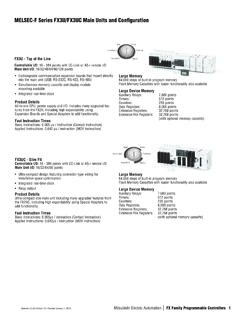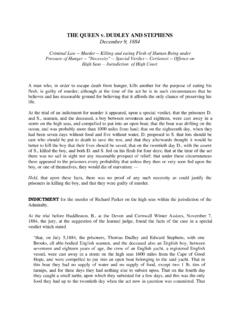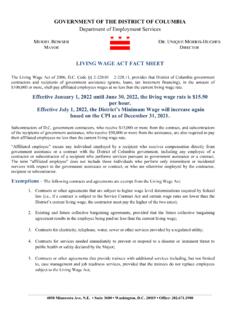Transcription of Understanding Separation Anxiety in Infants and Young Children
1 Understanding Separation Anxiety in Infants and Young Children OSSE 2016 Infant and Toddler Conference May 20, 2016. Presented by: DC Department of Behavioral Health, Prevention and Early Intervention Programs, Healthy Futures Learning Objectives To understand Separation Anxiety Object Permanence Attachment Theory Temperament Types Separation Anxiety is typical in very Young Children (those between 8 and 14 months old). Children often go through a phase when they are "clingy" and afraid of unfamiliar people and places. How Separation Anxiety Develops Babies adapt pretty well to other caregivers. Parents probably feel more Anxiety about being separated than Infants do! As long as their needs are being met, most babies younger than 6 months adjust easily to other people.
2 Sometime between 4-7 months, babies develop a sense of object permanence and begin to learn that things and people exist even when they're out of sight. This is when babies start playing the "dropsy" game dropping things over the side of the high chair and expecting an adult to pick them up (which, once retrieved, get dropped again!). The same thing occurs with a parent. Babies realize that there's only mom or dad, and when they can't see you, that means you've gone away. And most don't yet understand the concept of time so they do not know if or when you'll come back. Whether you're in the kitchen, in the next bedroom, or at the office, it's all the same to your baby. You've disappeared, and your child will do whatever he or she can to prevent this from happening.
3 Facts about Separation Anxiety Infants : Separation Anxiety develops after a child gains an Understanding of object permanence. Once your infant realizes you're really gone (when you are), it may leave him unsettled. Although some babies display object permanence and Separation Anxiety as early as 4 to 5 months of age, most develop more robust Separation Anxiety at around 9 months. The leave- taking can be worse if your infant is hungry, tired, or not feeling well. Facts about Separation Anxiety Toddlers: Many toddlers skip Separation Anxiety in infancy and start demonstrating challenges at 15 or 18 months of age. Separations are more difficult when Children are hungry, tired, or sick which is most of toddlerhood!
4 As Children develop independence during toddlerhood, they may become even more aware of separations. Their behaviors at separations will be loud, tearful, and difficult to stop. Facts about Separation Anxiety Preschoolers: By the time Children are 3 years of age, most clearly understand the effect their Anxiety or pleas at Separation have on us. It doesn't mean they aren't stressed, but they certainly are vying for a change. Be consistent. Your ongoing consistency, explanations, and diligence to return when you say you will are tantamount. Jean Piaget: The Father of Object Permanence Swiss psychologist, Jean Piaget, conducted studies to show that object permanence plays an important role in cognitive development.
5 Young Infants do not yet possess the ability to remember or even think about things they cannot see. And this ability actually goes beyond 'out of sight, out of mind' because to them, if they cannot see it, it simply does not exist. In other words, their entire world is only what they can see at any given moment. This is why we may take a toy away from an infant and then infant will not react. The infant will not even cry or even try to look for what has disappeared. It's just gone as if it's never been there! Playing Object Permanence Games Peek-a-Boo From approximately 6-12 months of age, this is supposedly one of the best activities to teach Children that something or someone who cannot be seen still exists in their world.
6 For example covering a toy with a blanket then saying, Where's the ball? followed up by uncovering the toy and saying, Here's the ball! will help our Children understand that the ball did not disappear just because the blanket covered it. Hiding then reappearing from behind a door, playing with a Jack-in-the-box, or pulling objects from containers are also fun and effective ways to interact with our Children while helping facilitate their intellectual and emotional development. Playing Object Permanence Games 'Playing' Leave and Return Whether it is simply leaving a room or leaving Children with a babysitter and then reliably returning, this activity will help our Children realize that even when they cannot see us, they know we will always come back.
7 A caregiver who is regularly out of sight yet consistently returns can actually encourage the development of object permanence as well as a strong sense of security. Since many people suggest that object permanence involves all the senses, not simply visual perception, we can help solidify the idea by calling our Children when we are away so that they hear our voices and realize that we still exist even though they cannot see us. Ensuring a Secure Environment One of the best ways to help develop object permanence is to give Young Infants a secure, dependable, and loving environment in which to learn. It is important to introduce regular routines and familiar patterns so that babies start to establish a sense of expectation.
8 So, by giving our Children reliable and stable environments we are encouraging object permanence and all the benefits this concept includes. Object Permanence Video The Good News about Baby Separation Anxiety It's a positive, healthy sign: Separation Anxiety in babies is an absolutely normal and healthy phase of child development. It will lessen and pass: Each baby is different, but typical baby Separation Anxiety is said to occur somewhere between 7-18 months and last about 2-5 months. (And if your baby or toddler doesn't show signs of Separation Anxiety , it doesn't necessarily mean that something is 'wrong' - just like we adults have distinct personalities, so do babies). Your baby is securely attached to you (secure attachment is a term from attachment theory: The fact that your baby wants you all the time means that you've done a great job.)
9 Your bond is strong and healthy. Your baby associates you with security and love and feels 'whole' when you are together. The Good News about Baby Separation Anxiety Your baby is getting smart: Your baby's brain is really on the fast track now. Your baby has discovered that he or she can affect the world with his or her actions; 'I cry, Mom comes!'. This is a great step, 'but' it also means .. Your baby is starting to remember: Before your baby was completely living in the now; No recollection of the past and no anticipation of the future. Now your baby remembers that you were there a minute ago but you're not here now. Your baby is now doing abstract thinking, wow! Your baby can now create an image of something not present, in this case, you!
10 (This step in child development is called object permanence - the object remains in your baby's mind, so to speak). However, your baby is still so much in the 'now' that he or she thinks your absence is permanent. Your baby hasn't yet learnt that when you leave, you will come back. Attachment Theory British psychologist John Bowlby was the first attachment theorist, describing attachment as a "lasting psychological connectedness between human beings.". Attachment theory suggests that the relationship Children have with their earliest caregivers colors all their future relationships. That means our emotional and social behavior in adolescence and adulthood mirrors the patterns we developed with our first carers.

















